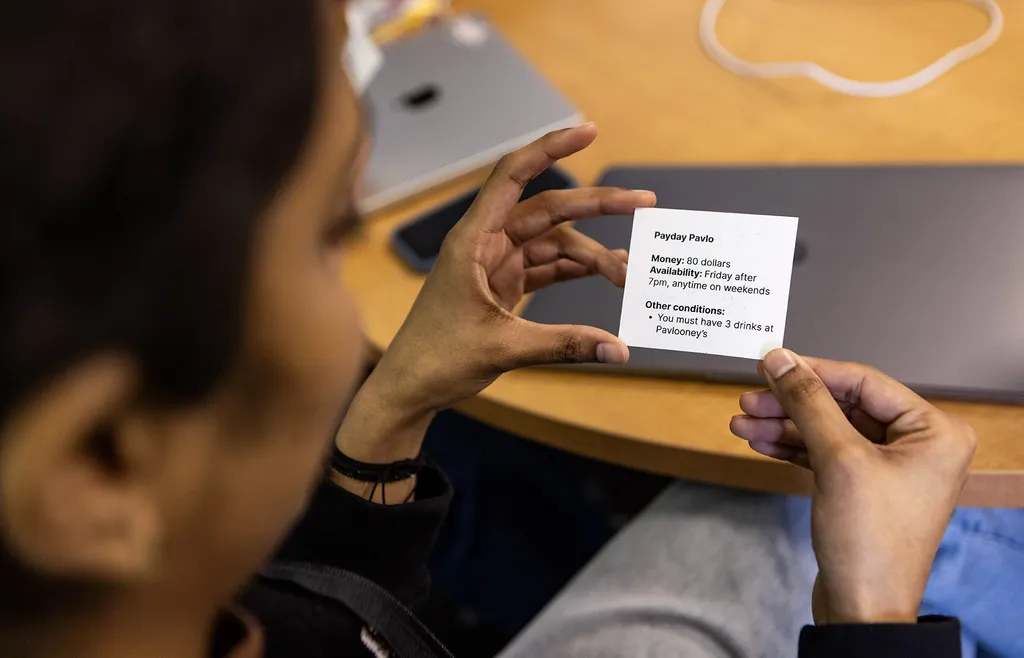- April 28, 2025
- By Annie Krakower
A typical night for a college student might be to read a textbook chapter or watch a lecture for homework and then fire up the PS5 or Switch. But for Terps in one University of Maryland class, the video games are the homework.
The College of Information course, “Games as Emergent Experiences,” explores how different aspects of video game design, from the characters to the music to the aesthetics, affect how well players can immerse themselves in the digital environments. Students level up each week by completing three “quests”: reading about a game element, watching a video on the same topic, then taking a related game for a spin themselves.
“Play and learning are actually inextricably intertwined. If you’re playing, you’re learning something,” said Assistant Professor Caro Williams-Pierce, who teaches the course. “With games, you get to experiment with sometimes fundamentally different worldviews in a low-stakes, optional way.”
Having grown up in rural Maine without access to video games or even a computer, she jokes that she’s now “making up for lost time.” After friends introduced her to role-playing classics like “Diablo II” and “World of Warcraft,” she combined her newfound love of gaming with her curriculum and instruction grad school studies at the University of Wisconsin to develop her read-watch-play methodology, which she’s used since she started teaching the class at UMD in 2020.
“It is more interesting and motivating than just reading a bunch of readings,” said Uhjin Sim, a first-year information science Ph.D. student, who likened earning points for each task to completing levels in a game. “The whole concept is very fitting to the nature of this class.”
Students—whether undergraduate or graduate, gaming experts or novices—then take turns leading the class discussion each week. In one recent lesson, human-computer interaction master’s students Yabing Yang and Ruibin Zheng delved into how players become characters immersed in virtual worlds. Do effective tutorials or accurate cultural context in games, they asked, foster deeper connections? And how does an audio-only game—like “Zombies, Run,” a fitness app that prompts users to jog faster as sounds of the undead get closer—affect the emergent experience?

The class tested out theories on what makes characters engaging through in-person games of their own. In one, Terps played the role of fictional grad student Pavlo, who had to convince as many peers as he could to join him at the bar Pavlooney’s based on their assigned conditions, like their availability and how much money they had. In the other, a mix of Clue and charades, students were limited to nonverbal cues like gestures and drawings as they played detectives investigating a murder. Classmates agreed each game’s rules and background helped them feel more immersed.
Other classes this semester have explored everything from how a game’s soundtrack enhances user experience—would remixing the music of horror game “Five Nights at Freddy’s” make it less terrifying?—to how failure and feedback in a game can encourage improvement—does the demise of the character Yarny in the puzzle game “Unravel” make players want to try again?
“Playing the games for this class has been a bit of an eye-opener,” said information management master’s student Shahrukh Gizabi ’24, who outside of class enjoys high-difficulty role-playing games like “Elden Ring.” “It’s been a pretty exciting experience stepping out of my comfort zone in terms of the games I typically play.”

Besides teaching the elective—a good fit for students interested in digital learning, human-computer interaction or user experience—Williams-Pierce hopes to expand play’s role in education at UMD and beyond. Through a Teaching Innovation Grant, she’s researching and developing an online platform to help faculty incorporate the read-watch-play pedagogy into their fields and gamify their classes. It’s not restricted to games, she says; mathematicians or scientists, for example, can “play” with difficult problems as well.
“There is so much evidence of the power of play for all ages and the authenticity of play even in advanced topics,” Williams-Pierce said. “This is a way to reframe what it means to teach and learn.”
All through April, Maryland Today will celebrate how the University of Maryland is reimagining learning and teaching. Find more stories at today.umd.edu/topic/we-reimagine-learning.
Topics
Campus & CommunityTags
Student ExperienceUnits
College of Information